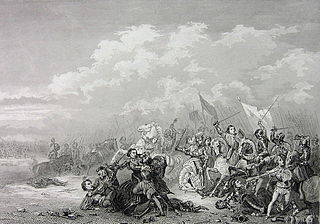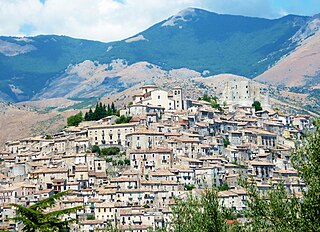
Peter III of Aragon was King of Aragon, King of Valencia, and Count of Barcelona from 1276 to his death. At the invitation of some rebels, he conquered the Kingdom of Sicily and became King of Sicily in 1282, pressing the claim of his wife, Constance II of Sicily, uniting the kingdom to the crown.

Frederick II ; 13 December 1272 – 25 June 1337) was the regent of the Kingdom of Sicily from 1291 until 1295 and subsequently King of Sicily from 1295 until his death. He was the third son of Peter III of Aragon and served in the War of the Sicilian Vespers on behalf of his father and brothers, Alfonso ΙΙΙ and James ΙΙ. He was confirmed as king by the Peace of Caltabellotta in 1302. His reign saw important constitutional reforms: the Constitutiones regales, Capitula alia, and Ordinationes generales.

Charles II, also known as Charles the Lame, was King of Naples, Count of Provence and Forcalquier (1285–1309), Prince of Achaea (1285–1289), and Count of Anjou and Maine (1285–1290); he also was King of Albania (1285–1294), and claimed the Kingdom of Jerusalem from 1285. He was the son of Charles I of Anjou—one of the most powerful European monarchs in the second half of the 13th century—and Beatrice of Provence. His father granted Charles the Principality of Salerno in the Kingdom of Sicily in 1272 and made him regent in Provence and Forcalquier in 1279.

Ferdinand I was King of the Two Sicilies from 1816 until his death. Before that he had been, since 1759, King of Naples as Ferdinand IV and King of Sicily as Ferdinand III. He was deposed twice from the throne of Naples: once by the revolutionary Parthenopean Republic for six months in 1799, and again by a French invasion in 1806, before being restored in 1815 at the end of the Napoleonic Wars.

The Battle of Maida, fought on 4 July 1806 was a battle between the British expeditionary force and a French force outside the town of Maida in Calabria, Italy during the Napoleonic Wars. John Stuart led 5,236 Anglo-Sicilian troops to victory over about 5,400 Franco-Italian-Polish troops under the command of French general Jean Reynier, inflicting significant losses while incurring relatively few casualties. Maida is located in the toe of Italy, about 30 kilometres (19 mi) west of Catanzaro.

Philip II, also known as Philip I of Taranto, was titular Latin Emperor of Constantinople by marriage to Catherine of Valois–Courtenay, Despot of Romania, King of Albania, Prince of Achaea and Taranto.

Roger of Lauria (c. 1245 – 17 January 1305), was a Calabrian knight who served the Crown of Aragon as admiral of the Aragonese navy during the War of the Sicilian Vespers. He was probably the most successful and talented naval tactician of the Middle Ages. He is known as Ruggero or Ruggiero di Lauria in Italian and Roger de Llúria in Catalan.

Louis the Child was King of Sicily from 15 September 1342 until his death. He was a minor upon his succession, and was under a regency until 1354. His actual rule was short, for he died in an outbreak of plague the next year. His reign was marked by civil war.
The naval Battle of Cape Orlando took place on 4 July 1299 at St Marco di Val Demone, north-western Sicily, when an Aragonese and Angevin galley fleet commanded by Roger of Lauria defeated a Sicilian galley fleet commanded by Conrad d'Oria. King James II of Aragon and Frederick III of Sicily were present with their fleets at the battle. The larger Aragonese–Angevin fleet was trapped on a lee shore but was able to win the battle with the intervention of its six-galley reserve that attacked the rear of the Sicilian fleet. The Sicilians fled when the flagship, with Frederick aboard, pulled back after the king collapsed from heat and exhaustion. Eighteen Sicilian vessels were captured and their crews massacred. The battle allowed for the invasion of Sicily but James, breaking with his Angevin allies, withdrew his force to Aragon and Frederick was able to defeat the Angevin army on land and secure the independence of Sicily in the Peace of Caltabellotta.

The War of the Sicilian Vespers, also shortened to the War of the Vespers, was a conflict waged by several medieval European kingdoms over control of Sicily from 1282 to 1302. The war, which started with the revolt of the Sicilian Vespers, was fought over competing dynastic claims to the throne of Sicily and grew to involve the Crown of Aragon, Angevin Kingdom of Naples, Kingdom of France, and the papacy.

The Battle of Seminara, part of the First Italian War, was fought in Calabria on 28 June 1495 between a French garrison in recently conquered Southern Italy and the allied forces of Spain and Naples which were attempting to reconquer these territories. Against the redoubtable combination of gendarmes and Swiss mercenary pikemen in the French force, the allies had only Neapolitan troops of indifferent quality and a small corps of lightly-armed Spanish soldiers, accustomed to fighting the Moors of Spain. The result was a rout, and much of the fighting centered on delaying actions to permit the fleeing allied force to escape.

The Capetian House of Anjou, or House of Anjou-Sicily, or House of Anjou-Naples was a royal house and cadet branch of the Capetian dynasty. It is one of three separate royal houses referred to as Angevin, meaning "from Anjou" in France. Founded by Charles I of Anjou, the youngest son of Louis VIII of France, the Capetian king first ruled the Kingdom of Sicily during the 13th century. The War of the Sicilian Vespers later forced him out of the island of Sicily, which left him with the southern half of the Italian Peninsula, the Kingdom of Naples. The house and its various branches would go on to influence much of the history of Southern and Central Europe during the Middle Ages until it became extinct in 1435.

The Battle of Campo Tenese saw two divisions of the Imperial French Army of Naples led by Jean Reynier attack the left wing of the Royal Neapolitan Army under Roger de Damas. Though the defenders were protected by field fortifications, a French frontal attack combined with a turning movement rapidly overran the position and routed the Neapolitans with heavy losses. The action occurred at Campotenese, a little mountain village in the municipality of Morano Calabro in the north of Calabria. The battle was fought during the War of the Third Coalition, part of the Napoleonic Wars.
An incomplete list of events in 1299 in Italy:

The House of Sanseverino was an Italian noble family that played a prominent role in the Kingdom of Sicily and were one of the seven great families in the Kingdom of Naples. The Marcellinara branch of this family continues to the present day.

Bernat de Rocafort was the third leader of the Catalan Company, from 1307 until 1309.
Blasco I Alagona or d'Alagona, called the Elder, was an Aragonese nobleman and soldier in the service of the Kingdom of Sicily after 1285. His family was originally from Alagón. As a military commander, he was noted for his adept use of mobile infantry against heavy cavalry.

The Battle of Gagliano was a military engagement between the forces of the Kingdom of Sicily and the Angevin Kingdom of Naples. Fought in early 1300 during the War of the Sicilian Vespers, the battle involved the entrapment and routing of a Angevin heavy cavalry detachment by a Sicilian force near the fortified town of Gagliano Castelferrato in central Sicily.

The Angevin invasion of Sicily (1298–1302) was a military campaign launched against the Kingdom of Sicily by an alliance of the Angevin Kingdom of Naples, the Crown of Aragon, and the papacy during the War of the Sicilian Vespers. Fought in the final years of the 20-year long war, the campaign saw the alliance make some territorial gains on the island before ultimately withdrawing in the face of Sicilian resistance.

The First War of Sicily was a protracted conflict for control of the Kingdom of Sicily and naval dominance in the Mediterranean, spanning from 1282 to 1302. This article focuses on the initial phase of the war (1282–1294), fought between the Crown of Aragon and the House of Anjou, which held power in Naples and France. For the main article on the conflict, see War of the Sicilian Vespers.















